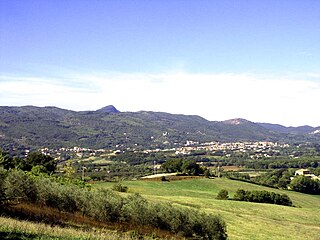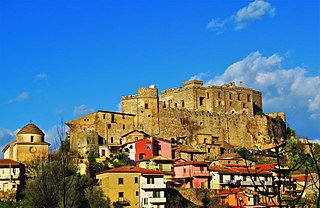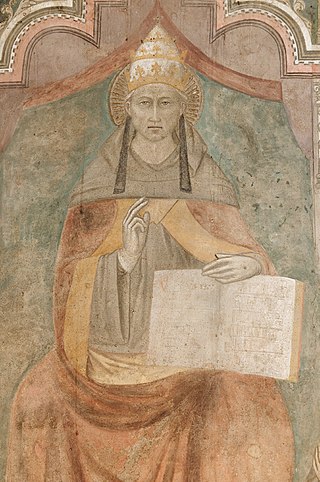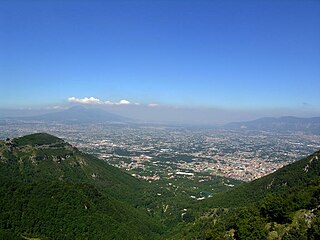Related Research Articles

The province of Caserta is a province in the Campania region of southern Italy. Its capital is the city of Caserta, situated about 36 kilometres (22 mi) by road north of Naples. The province has an area of 2,651.35 square kilometres (1,023.69 sq mi), and had a total population of 924,414 in 2016. The Palace of Caserta is located near to the city, a former royal residence which was constructed for the Bourbon kings of Naples. It was the largest palace and one of the largest buildings erected in Europe during the 18th century. In 1997, the palace was designated a UNESCO World Heritage Site.
Castel Morrone is a comune (municipality) in the Province of Caserta in the Italian region Campania, located about 35 kilometres (22 mi) north of Naples and about 6 kilometres (4 mi) north of Caserta.
Piana di Monte Verna is a comune (municipality) in the Province of Caserta in the Italian region Campania, located about 40 kilometres (25 mi) north of Naples and about 11 kilometres (7 mi) north of Caserta.

Limatola is a comune (municipality) in the Province of Benevento in the Italian region Campania, located about 35 km northeast of Naples and about 30 km west of Benevento.

Castel Nuovo, often called Maschio Angioino, is a medieval castle located in front of Piazza Municipio and the city hall in central Naples, Campania, Italy. Its scenic location and imposing size makes the castle, first erected in 1279, one of the main architectural landmarks of the city. It was a royal seat for kings of Naples, Aragon and Spain until 1815.

The 1292–94 papal election, was the last papal election which did not take the form of a papal conclave. After the death of Pope Nicholas IV on 4 April 1292, the eleven surviving cardinals deliberated for more than two years before electing the third of six non-cardinals to be elected pope during the Late Middle Ages: Pietro da Morrone, who took the name Pope Celestine V.

The Asinara, Italian: Asino dell'Asinara, is a breed of feral donkey indigenous to the island of Asinara, which lies off the north-west coast of Sardinia, Italy, in the province of Sassari. Most of the population is wholly or partly albinistic; the small number of grey donkeys on the island are also considered part of the population, and may be heterozygous carriers of the albino gene. The Asinara is one of the eight autochthonous donkey breeds of limited distribution recognised by the Ministero delle Politiche Agricole Alimentari e Forestali, the Italian ministry of agriculture and forestry. It is called ainu, borricu or molenti in Sardinian.
The Bianca di Saluzzo is a traditional breed of chicken originating in the Piedmont region of north-western Italy. It takes its name either from the town of Saluzzo, in the province of Cuneo, or from the former Marquisate of Saluzzo, which approximately coincides with its area of distribution. It may also be called the Bianca di Cavour, after the nearby town of Cavour, in the province of Turin.

The Valdarno is an Italian breed of black dual-purpose chicken. It originates in, and is named for, the lower part of the Valdarno, the valley of the Arno river, in Tuscany in central Italy. It became virtually extinct in the twentieth century, but the population is recovering. It is a quite different breed from the Valdarnese, which originates in the upper Valdarno, and is white.

The Amiatina or Italian: Asino dell'Amiata is a breed of donkey from Tuscany in central Italy. It is particularly associated with Monte Amiata in the provinces of Siena and Grosseto, but is distributed throughout Tuscany. There are also populations in Liguria and in Campania. It is one of the eight autochthonous donkey breeds of limited distribution recognised by the Ministero delle Politiche Agricole Alimentari e Forestali, the Italian ministry of agriculture and forestry.
The Pantesco or Asino di Pantelleria is an Italian breed of donkey from the Mediterranean island of Pantelleria, south-west of Sicily. It is at high risk of extinction and was listed as "critical" by the FAO in 2007. It is one of the eight autochthonous donkey breeds of limited distribution recognised by the Ministero delle Politiche Agricole Alimentari e Forestali, the Italian ministry of agriculture and forestry.

The Martina Franca donkey, Italian: Asino di Martina Franca, is a breed of donkey from Puglia in southern Italy. It is the largest Italian donkey breed, and was famous for its qualities in the production of mules. It is particularly associated with the comune of Martina Franca from which it takes its name, but the area of origin also includes Alberobello, Ceglie Messapica, Locorotondo, Massafra, Mottola and Noci, in the provinces of Bari, Brindisi and Taranto. It is still raised mainly in Puglia, but there are also populations in Abruzzo, Lazio, Lombardy and Umbria. It is one of the eight autochthonous donkey breeds of limited distribution recognised by the Ministero delle Politiche Agricole Alimentari e Forestali, the Italian ministry of agriculture and forestry.
The Grigio Siciliano or Asino Ferrante, is a breed of donkey from the Mediterranean island of Sicily in southern Italy. It is bred only on the island, in the provinces of Agrigento, Enna, Palermo, Ragusa and Syracuse. The conservation status of the Grigio Siciliano was listed as "critical" by the FAO in 2007. In 2012 it was not among the autochthonous donkey breeds of limited distribution recognised by the Ministero delle Politiche Agricole Alimentari e Forestali, the Italian ministry of agriculture and forestry. A recent census conducted by researchers at the University of Messina counted approximately 100 individuals between 4 months and 14 years old.
The Savoiarda or razza di Cuorgné is a threatened breed of upland sheep from the province of Turin, in Piemonte, north-west Italy. The few remaining breeders are in the Val Chisone, the Val di Susa, the Valli di Lanzo and the Val Pellice.
The Gentile di Puglia is a breed of domestic sheep indigenous to southern Italy. It originates from the Tavoliere di Foggia, a large plain in the northern part of Puglia, and is raised mainly in that region; a few are found in neighbouring regions. The Gentile di Puglia is sometimes known as the Merinos d'Italia, or Italian merino.
The Sempione is a rare breed of domestic goat from the mountains of Piemonte in north-western Italy and the neighbouring area of Simplon in the canton of Valais in Switzerland; Sempione is the Italian name for Simplon. The Sempione goat is well documented in photographs from the early twentieth century, but is now thought to be close to extinction, and has more than once been considered extinct. Examples were recorded at Saliceto di Cravagliana in the province of Vercelli in 1983, and others have since been identified in the province of Verbano-Cusio-Ossola, particularly in the Val Divedro and the upper Ossola.

The Agro Nocerino Sarnese is a geographical region of the Province of Salerno, in Campania in southern Italy; the river Sarno flows through it. It is a low-lying area bounded to the south by the Monti Lattari, to the east and north-east by the Monti Picentini and to the west by the plain of Vesuvius. It consists of sixteen comuni: Angri, Bracigliano, Castel San Giorgio, Corbara, Nocera Inferiore, Nocera Superiore, Pagani, Roccapiemonte, San Marzano sul Sarno, San Valentino Torio, Santa Maria la Carità, Sant'Antonio Abate, Sant'Egidio del Monte Albino, Sarno, Scafati and Siano. All are in the province of Salerno except Santa Maria la Carità and Sant'Antonio Abate, which are in the province of Naples.
The Lariana or Capra di Livo is an indigenous breed of domestic goat from the province of Como, in Lombardy in northern Italy. It is raised in the Livo valley and throughout the western Lario; the two names of the breed derive from these places. It is of Alpine type and has highly variable characteristics. Management is extensive: the animals are kept on alpine pasture from May to December, and brought under cover for the winter months.
The Di L'Aquila or Capra di L'Aquila is an indigenous breed of domestic goat from the province of L'Aquila, in Abruzzo in southern Italy. It is raised only in that province. It is a heterogeneous breed with variable characteristics, showing the influence of introductions of Alpina Comune, Girgentana, Maltese and Toggenburg stock. It is large, hardy and productive. Management is extensive: the animals are kept on mountain pasture, and brought under cover for protection from the snow only in the winter months.
References
- ↑ ‘Razze Asini: Razze italiane minori’, Agraria.org.
- 1 2 3 ‘I Biotopi’, Comune di Castel Morrone.